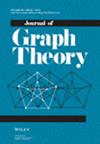求助PDF
{"title":"厄尔多斯-雷尼图中命中时间的浓度","authors":"Andrea Ottolini, Stefan Steinerberger","doi":"10.1002/jgt.23119","DOIUrl":null,"url":null,"abstract":"<p>We consider Erdős-Rényi graphs <span></span><math>\n <semantics>\n <mrow>\n <mi>G</mi>\n <mrow>\n <mo>(</mo>\n <mrow>\n <mi>n</mi>\n <mo>,</mo>\n <mi>p</mi>\n </mrow>\n <mo>)</mo>\n </mrow>\n </mrow>\n <annotation> $G(n,p)$</annotation>\n </semantics></math> for <span></span><math>\n <semantics>\n <mrow>\n <mn>0</mn>\n <mo><</mo>\n <mi>p</mi>\n <mo><</mo>\n <mn>1</mn>\n </mrow>\n <annotation> $0\\lt p\\lt 1$</annotation>\n </semantics></math> fixed and <span></span><math>\n <semantics>\n <mrow>\n <mi>n</mi>\n <mo>→</mo>\n <mi>∞</mi>\n </mrow>\n <annotation> $n\\to \\infty $</annotation>\n </semantics></math> and study the expected number of steps, <span></span><math>\n <semantics>\n <mrow>\n <msub>\n <mi>H</mi>\n <mrow>\n <mi>w</mi>\n <mi>v</mi>\n </mrow>\n </msub>\n </mrow>\n <annotation> ${H}_{wv}$</annotation>\n </semantics></math>, that a random walk started in <span></span><math>\n <semantics>\n <mrow>\n <mi>w</mi>\n </mrow>\n <annotation> $w$</annotation>\n </semantics></math> needs to first arrive in <span></span><math>\n <semantics>\n <mrow>\n <mi>v</mi>\n </mrow>\n <annotation> $v$</annotation>\n </semantics></math>. A natural guess is that an Erdős-Rényi random graph is so homogeneous that it does not really distinguish between vertices and <span></span><math>\n <semantics>\n <mrow>\n <msub>\n <mi>H</mi>\n <mrow>\n <mi>w</mi>\n <mi>v</mi>\n </mrow>\n </msub>\n <mo>=</mo>\n <mrow>\n <mo>(</mo>\n <mrow>\n <mn>1</mn>\n <mo>+</mo>\n <mi>o</mi>\n <mrow>\n <mo>(</mo>\n <mn>1</mn>\n <mo>)</mo>\n </mrow>\n </mrow>\n <mo>)</mo>\n </mrow>\n <mi>n</mi>\n </mrow>\n <annotation> ${H}_{wv}=(1+o(1))n$</annotation>\n </semantics></math>. Löwe-Terveer established a CLT for the Mean Starting Hitting Time suggesting <span></span><math>\n <semantics>\n <mrow>\n <msub>\n <mi>H</mi>\n <mrow>\n <mi>w</mi>\n <mi>v</mi>\n </mrow>\n </msub>\n <mo>=</mo>\n <mi>n</mi>\n <mo>±</mo>\n <mi>O</mi>\n <mrow>\n <mo>(</mo>\n <msqrt>\n <mi>n</mi>\n </msqrt>\n <mo>)</mo>\n </mrow>\n </mrow>\n <annotation> ${H}_{wv}=n\\pm {\\mathscr{O}}(\\sqrt{n})$</annotation>\n </semantics></math>. We prove the existence of a strong concentration phenomenon: <span></span><math>\n <semantics>\n <mrow>\n <msub>\n <mi>H</mi>\n <mrow>\n <mi>w</mi>\n <mi>v</mi>\n </mrow>\n </msub>\n </mrow>\n <annotation> ${H}_{wv}$</annotation>\n </semantics></math> is given, up to a very small error of size <span></span><math>\n <semantics>\n <mrow>\n <mo>≲</mo>\n <msup>\n <mrow>\n <mo>(</mo>\n <mrow>\n <mi>log</mi>\n <mi>n</mi>\n </mrow>\n <mo>)</mo>\n </mrow>\n <mrow>\n <mn>3</mn>\n <mo>∕</mo>\n <mn>2</mn>\n </mrow>\n </msup>\n <mo>∕</mo>\n <msqrt>\n <mi>n</mi>\n </msqrt>\n </mrow>\n <annotation> $\\lesssim {(\\mathrm{log}n)}^{3\\unicode{x02215}2}\\unicode{x02215}\\sqrt{n}$</annotation>\n </semantics></math>, by an explicit simple formula involving only the total number of edges <span></span><math>\n <semantics>\n <mrow>\n <mo>∣</mo>\n <mi>E</mi>\n <mo>∣</mo>\n </mrow>\n <annotation> $| E| $</annotation>\n </semantics></math>, the degree <span></span><math>\n <semantics>\n <mrow>\n <mtext>deg</mtext>\n <mrow>\n <mo>(</mo>\n <mi>v</mi>\n <mo>)</mo>\n </mrow>\n </mrow>\n <annotation> $\\text{deg}(v)$</annotation>\n </semantics></math> and the distance <span></span><math>\n <semantics>\n <mrow>\n <mi>d</mi>\n <mrow>\n <mo>(</mo>\n <mrow>\n <mi>v</mi>\n <mo>,</mo>\n <mi>w</mi>\n </mrow>\n <mo>)</mo>\n </mrow>\n </mrow>\n <annotation> $d(v,w)$</annotation>\n </semantics></math>.</p>","PeriodicalId":16014,"journal":{"name":"Journal of Graph Theory","volume":"107 2","pages":"245-262"},"PeriodicalIF":0.9000,"publicationDate":"2024-05-12","publicationTypes":"Journal Article","fieldsOfStudy":null,"isOpenAccess":false,"openAccessPdf":"","citationCount":"0","resultStr":"{\"title\":\"Concentration of hitting times in Erdős-Rényi graphs\",\"authors\":\"Andrea Ottolini, Stefan Steinerberger\",\"doi\":\"10.1002/jgt.23119\",\"DOIUrl\":null,\"url\":null,\"abstract\":\"<p>We consider Erdős-Rényi graphs <span></span><math>\\n <semantics>\\n <mrow>\\n <mi>G</mi>\\n <mrow>\\n <mo>(</mo>\\n <mrow>\\n <mi>n</mi>\\n <mo>,</mo>\\n <mi>p</mi>\\n </mrow>\\n <mo>)</mo>\\n </mrow>\\n </mrow>\\n <annotation> $G(n,p)$</annotation>\\n </semantics></math> for <span></span><math>\\n <semantics>\\n <mrow>\\n <mn>0</mn>\\n <mo><</mo>\\n <mi>p</mi>\\n <mo><</mo>\\n <mn>1</mn>\\n </mrow>\\n <annotation> $0\\\\lt p\\\\lt 1$</annotation>\\n </semantics></math> fixed and <span></span><math>\\n <semantics>\\n <mrow>\\n <mi>n</mi>\\n <mo>→</mo>\\n <mi>∞</mi>\\n </mrow>\\n <annotation> $n\\\\to \\\\infty $</annotation>\\n </semantics></math> and study the expected number of steps, <span></span><math>\\n <semantics>\\n <mrow>\\n <msub>\\n <mi>H</mi>\\n <mrow>\\n <mi>w</mi>\\n <mi>v</mi>\\n </mrow>\\n </msub>\\n </mrow>\\n <annotation> ${H}_{wv}$</annotation>\\n </semantics></math>, that a random walk started in <span></span><math>\\n <semantics>\\n <mrow>\\n <mi>w</mi>\\n </mrow>\\n <annotation> $w$</annotation>\\n </semantics></math> needs to first arrive in <span></span><math>\\n <semantics>\\n <mrow>\\n <mi>v</mi>\\n </mrow>\\n <annotation> $v$</annotation>\\n </semantics></math>. A natural guess is that an Erdős-Rényi random graph is so homogeneous that it does not really distinguish between vertices and <span></span><math>\\n <semantics>\\n <mrow>\\n <msub>\\n <mi>H</mi>\\n <mrow>\\n <mi>w</mi>\\n <mi>v</mi>\\n </mrow>\\n </msub>\\n <mo>=</mo>\\n <mrow>\\n <mo>(</mo>\\n <mrow>\\n <mn>1</mn>\\n <mo>+</mo>\\n <mi>o</mi>\\n <mrow>\\n <mo>(</mo>\\n <mn>1</mn>\\n <mo>)</mo>\\n </mrow>\\n </mrow>\\n <mo>)</mo>\\n </mrow>\\n <mi>n</mi>\\n </mrow>\\n <annotation> ${H}_{wv}=(1+o(1))n$</annotation>\\n </semantics></math>. Löwe-Terveer established a CLT for the Mean Starting Hitting Time suggesting <span></span><math>\\n <semantics>\\n <mrow>\\n <msub>\\n <mi>H</mi>\\n <mrow>\\n <mi>w</mi>\\n <mi>v</mi>\\n </mrow>\\n </msub>\\n <mo>=</mo>\\n <mi>n</mi>\\n <mo>±</mo>\\n <mi>O</mi>\\n <mrow>\\n <mo>(</mo>\\n <msqrt>\\n <mi>n</mi>\\n </msqrt>\\n <mo>)</mo>\\n </mrow>\\n </mrow>\\n <annotation> ${H}_{wv}=n\\\\pm {\\\\mathscr{O}}(\\\\sqrt{n})$</annotation>\\n </semantics></math>. We prove the existence of a strong concentration phenomenon: <span></span><math>\\n <semantics>\\n <mrow>\\n <msub>\\n <mi>H</mi>\\n <mrow>\\n <mi>w</mi>\\n <mi>v</mi>\\n </mrow>\\n </msub>\\n </mrow>\\n <annotation> ${H}_{wv}$</annotation>\\n </semantics></math> is given, up to a very small error of size <span></span><math>\\n <semantics>\\n <mrow>\\n <mo>≲</mo>\\n <msup>\\n <mrow>\\n <mo>(</mo>\\n <mrow>\\n <mi>log</mi>\\n <mi>n</mi>\\n </mrow>\\n <mo>)</mo>\\n </mrow>\\n <mrow>\\n <mn>3</mn>\\n <mo>∕</mo>\\n <mn>2</mn>\\n </mrow>\\n </msup>\\n <mo>∕</mo>\\n <msqrt>\\n <mi>n</mi>\\n </msqrt>\\n </mrow>\\n <annotation> $\\\\lesssim {(\\\\mathrm{log}n)}^{3\\\\unicode{x02215}2}\\\\unicode{x02215}\\\\sqrt{n}$</annotation>\\n </semantics></math>, by an explicit simple formula involving only the total number of edges <span></span><math>\\n <semantics>\\n <mrow>\\n <mo>∣</mo>\\n <mi>E</mi>\\n <mo>∣</mo>\\n </mrow>\\n <annotation> $| E| $</annotation>\\n </semantics></math>, the degree <span></span><math>\\n <semantics>\\n <mrow>\\n <mtext>deg</mtext>\\n <mrow>\\n <mo>(</mo>\\n <mi>v</mi>\\n <mo>)</mo>\\n </mrow>\\n </mrow>\\n <annotation> $\\\\text{deg}(v)$</annotation>\\n </semantics></math> and the distance <span></span><math>\\n <semantics>\\n <mrow>\\n <mi>d</mi>\\n <mrow>\\n <mo>(</mo>\\n <mrow>\\n <mi>v</mi>\\n <mo>,</mo>\\n <mi>w</mi>\\n </mrow>\\n <mo>)</mo>\\n </mrow>\\n </mrow>\\n <annotation> $d(v,w)$</annotation>\\n </semantics></math>.</p>\",\"PeriodicalId\":16014,\"journal\":{\"name\":\"Journal of Graph Theory\",\"volume\":\"107 2\",\"pages\":\"245-262\"},\"PeriodicalIF\":0.9000,\"publicationDate\":\"2024-05-12\",\"publicationTypes\":\"Journal Article\",\"fieldsOfStudy\":null,\"isOpenAccess\":false,\"openAccessPdf\":\"\",\"citationCount\":\"0\",\"resultStr\":null,\"platform\":\"Semanticscholar\",\"paperid\":null,\"PeriodicalName\":\"Journal of Graph Theory\",\"FirstCategoryId\":\"100\",\"ListUrlMain\":\"https://onlinelibrary.wiley.com/doi/10.1002/jgt.23119\",\"RegionNum\":3,\"RegionCategory\":\"数学\",\"ArticlePicture\":[],\"TitleCN\":null,\"AbstractTextCN\":null,\"PMCID\":null,\"EPubDate\":\"\",\"PubModel\":\"\",\"JCR\":\"Q2\",\"JCRName\":\"MATHEMATICS\",\"Score\":null,\"Total\":0}","platform":"Semanticscholar","paperid":null,"PeriodicalName":"Journal of Graph Theory","FirstCategoryId":"100","ListUrlMain":"https://onlinelibrary.wiley.com/doi/10.1002/jgt.23119","RegionNum":3,"RegionCategory":"数学","ArticlePicture":[],"TitleCN":null,"AbstractTextCN":null,"PMCID":null,"EPubDate":"","PubModel":"","JCR":"Q2","JCRName":"MATHEMATICS","Score":null,"Total":0}
引用次数: 0
引用
批量引用


